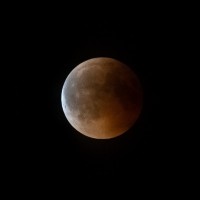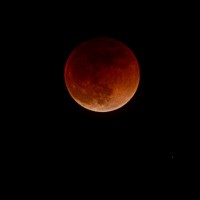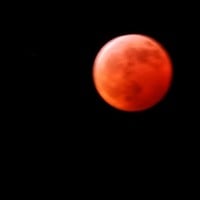Top 10 Lunar Eclipses of the 2010s
Lunar Eclipses (in which the moon passes through Earth's shadow) occur on a roughly equal frequency with Solar Eclipses but you are more likely to witness them in your lifetime since they can last up to nearly 2 hours and anyone on the night side of Earth can view them given the right weather conditions. These are the top eclipses of the decade (2010-2019). Feel free to share your eclipse experiences here.
With an umbral magnitude of 1.6087, it wasn't quite as deep as June 15th 2011's (which was 1.6999), but the Moon's father distance from Earth made up for it & it became the longest this century. It was the 38th member of 71 lunar eclipses in Lunar Saros 129 (with the previous eclipse on July 16th 2000 which was its deepest member at magnitude 1.7684 & was total for a whopping 106 minutes 25 seconds, which was just 3 seconds shorter than in August 13th 1859).
At 102 minutes and 57 seconds this is the longest of the 21st century (but not the longest of the millennium). Most of Africa, the Middle East and South Asia was able to see this. Sadly I was asleep at the time (It occurred at the very early morning here at the Philippines) so I didn't get to see it :(

Sometimes called the "super blue blood moon" due to 3 events happening simultaneously in one night. It's a super moon because it appears larger and brighter by a small amount. It's a blue moon because it's the second full moon of the month (the first occurred on January 2) and it's a blood moon due to it's reddish appearance (This occurs due to atmospheric refraction of red light to the moon). This is visible over most of Asia, Russia, and the western United States. The next occurrence will be on January 2037, still over the same location.

Visible over most of North America. Just under two years after the famed August 2017 Total Solar Eclipse. It's referred to as the "super wolf blood moon" because it occurred during a super moon and during the first month of the year (as referred to from the Farmer's Almanac). This is also the last Total Lunar Eclipse of the decade, the next won't be until May 26, 2021 (where I managed to photograph it)
This's the 1st total lunar eclipse where I photographed the Moon in all eclipse stages. At an umbral magnitude of 1.1953, it wasn't extremely shallow like the April 4th 2015 or May 26th, 2021 eclipses, but it wasn't so deep like on June 15th 2011 (at magnitude 1.6999, which was the deepest since July 16th 2000 - at magnitude 1.7684 - or July 27th 2018 which was the longest for this century & had an umbral magnitude of 1.6087) & it was a bit less deep than the September 28th 2015 eclipse (which was 1.282 in umbral magnitude & also happened during the supermoon). Yet 19 years before that marked 2000 in which a total eclipse also happened on January 21st (thanks to the Metonic cycle), except that was deeper (with an umbral magnitude of 1.3246) & longer in totality (15 minutes longer than this). Totality lasted 61 minutes 59 seconds & it was partial for 196 minutes 45 seconds & penumbral for 311 minutes 30 seconds all from beginning to end. Yet since it happened during the supermoon as it was less than 1 day before perigee, it was the perfect additional treat for great eclipse lunar photography in good weather conditions. Plus it was an extra treat when we detected a tiny meteor colliding with the Moon during totality. The image on this item was taken by me when it happened. It was the 27th member of 73 lunar eclipses in Lunar Saros 134 with the previous member on January 9th 2001 & the next member on January 31st 2037 which'll be the 1st that day since 2018 (as part of the ~19 year Metonic cycle).
This is the third eclipse of the 2014-2015 Blood Moon Tetrad (four consecutive total eclipses without any partial eclipses in between) and it was visible mostly over the Pacific. Normally Total Lunar Eclipses last many more minutes than even the longest Total or Annular Solar Eclipses, this however was the shortest Lunar Eclipse in the past 5 centuries, at only 4 minutes and 44 seconds. I wasn't able to see reddening of the moon as a result but I did saw it passing through Earth's shadow almost entirely.
Given how shallow this was (at magnitude 1.0008), it's easy to see why this was so short. Not since October 17th, 1529. So a lunar eclipse this short or shorter is truly a once in multiple lifetimes event. The total lunar eclipse in 1529 on the other hand was 1 minute 42 seconds. This was the 30th member of 71 lunar eclipses in Lunar Saros 132 & its 1st total member (while the 29th member on March 24th 1997 was a deep partial eclipse of magnitude 0.9195) & the 31st overall & 2nd total member will be on April 24th 2033 (at magnitude 1.0944).
It happened 1 hour after our Moon made its closest distance to Earth. Yet it was the 1st time since 2001 that this happened. Yet the Moon was halfway between the edge and center of Earth's umbra (at magnitude 1.282), so it wasn't as deep as what we had on June 15th, 2011 (at magnitude 1.6999) or July 28th, 2017 (at magnitude 1.6087), but the Moon was much darker than usual due to the leftover ash from the eruption of the Calbuco volcano in April that year. The next supermoon lunar eclipse happened on January 31st, 2018 (during a traditional blue moon), again on January 21st, 2019, and May 26th, 2021. Yet approximately 19 years ago (1 Metonic cycle), in 1996, we had a lunar eclipse just 1 day off on September 27th. It was the 28th member of 81 lunar eclipses in Lunar Saros 137, with the 27th member on September 14th, 1997 (though no supermoon with that), and the 29th member on October 8th, 2033 (which will happen during a supermoon, which will be the 1st during a lunar eclipse since May 26th, 2021).
Most of the Top Eclipses here are total ones but I have to give some credit to this partial eclipse. It is the last Lunar Eclipse of the decade and the next one (not counting penumbral eclipses) will not be until (the aforementioned) May 26, 2021. Also compared to other Partial Lunar Eclipses, this crossed much deeper into Earth's umbra. This can be seen over Africa, the Middle East, Europe, and Asia. Again I was asleep and it would most likely be close to moonset when it happened so no chances.
It was the 2nd lunar eclipse of 2019 & a deep partial eclipse with ~65.31% of our Moon in Earth's umbral shadow (hence an umbral magnitude of 0.6531). It was the 22nd member of 81 lunar eclipses in Lunar Saros 139 as well as the 1st on July 16th since 2000 (except that was total with an umbral magnitude of 1.7684 & totality lasting a whopping 106 minutes 25 seconds).
It had an umbral magnitude of 1.2561 & was total for 72 minutes 21 seconds. It was the 1st time since 1638 that a total lunar eclipse fell on the day of the Winter Solstice. There will be a total lunar eclipse roughly 1 day before the solstice (for the American timezones but on the solstice in Asian & Australian timezones) in 2029 as part of the ~19 year Metonic cycle.
Took place over North America and northwestern parts of South America
I remember this eclipse I didn't see most of it because I had to go to bed during it, it sucked
The second eclipse of the 2014-2015 tetrad. It can be seen over the Pacific, Canada and the United States. Despite being awake at the time, I didn't see it, probably due to clouds or I just didn't notice because back then I didn't know when and where eclipses happen. Lunar Eclipses like Solar Eclipses also follow a predictable pattern so that's why I can simply look up online to check for the next eclipse occurring over my area.
It was the 42nd member of 72 lunar eclipses in Lunar Saros 127. Totality lasted 58 minutes 50 seconds.
It happened ~6.7 days after apogee (the Moon's farthest approach from Earth), so the Moon looked unusually small from Earth. The umbral magnitude was 1.2962 (as the Moon was 29.62% of its mean diameter past the edge of totality) during its peak. Totality lasted 77 minutes 48 seconds & it was the 56th member of 75 lunar eclipses in Lunar Saros 122.
The first of the 2014-2015 tetrad. Occurred over North and South America